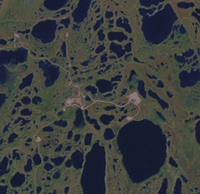
Photo from wikipedia
A geophysical test site (GTS) contains subsurface targets of known materials, orientations, and depths. GTSs offer unique opportunities for geophysical research, training, and educational activities. They provide platforms to investigate… Click to show full abstract
A geophysical test site (GTS) contains subsurface targets of known materials, orientations, and depths. GTSs offer unique opportunities for geophysical research, training, and educational activities. They provide platforms to investigate the penetration and resolution of different geophysical techniques for characterizing the shallow subsurface. GTS-based field exercises represent an interesting, motivating, rewarding, and enjoyable experience for students and instructors. We have constructed a GTS at Texas A&M University-Corpus Christi that contains several objects (e.g., steel drums, plastic drums, plastic buckets, steel pipes, and well covers) buried at depths ranging from 0.5 to 3 m to simulate real-life situations. In this article, we provide a thorough description of the site location, subsurface geology, surface topography, and construction methodology, as well as the types, locations, orientations, and depths of the subsurface targets. Research and education significance and implications of the GTS are also described. This article could serve as a reference for the construction of new GTSs worldwide.
Journal Title: Geophysics
Year Published: 2021
Link to full text (if available)
Share on Social Media: Sign Up to like & get
recommendations!